NSG2NCI: Exploring Chronic Illness, Patient Care & Australian Services
VerifiedAdded on 2023/06/07
|10
|2626
|500
Essay
AI Summary
This essay addresses the complexities of chronic illness management through the case of a 49-year-old patient, Liz, diagnosed with chronic bronchitis and other health issues. It explores the connection between conditions like hypertension, high cholesterol, smoking, and the risk of heart failure due to right ventricular failure. The essay identifies two beneficial services available in Australia: smoking cessation programs and primary healthcare initiatives focused on healthy dieting, lifestyles, and exercise. It reflects on the challenges in accessing these services, including equitable healthcare resource distribution and discrepancies in smoking cessation interventions. The conclusion emphasizes the patient's risk of heart failure and the importance of accessible support services, highlighting the need for addressing both acute and chronic health concerns.
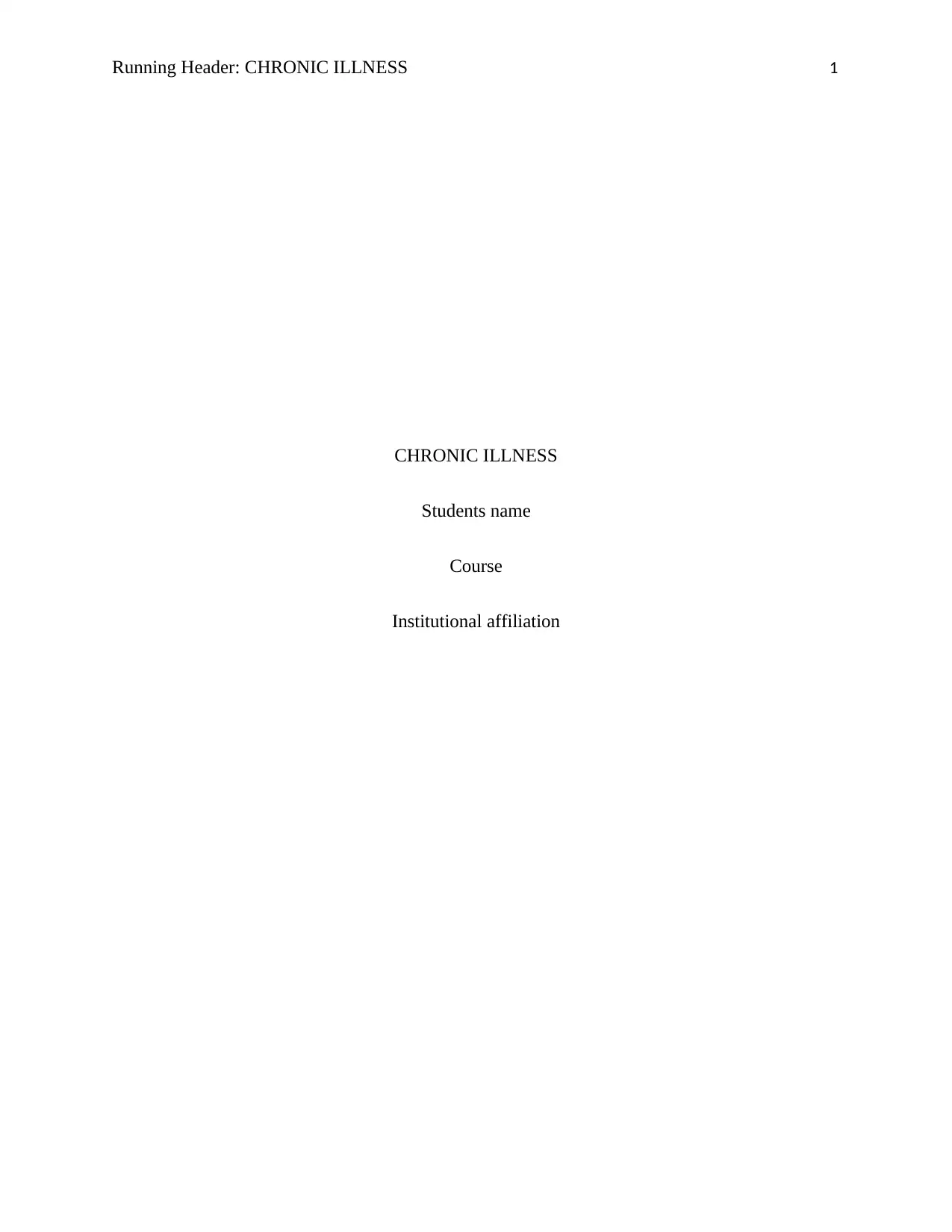
Running Header: CHRONIC ILLNESS 1
CHRONIC ILLNESS
Students name
Course
Institutional affiliation
CHRONIC ILLNESS
Students name
Course
Institutional affiliation
Paraphrase This Document
Need a fresh take? Get an instant paraphrase of this document with our AI Paraphraser
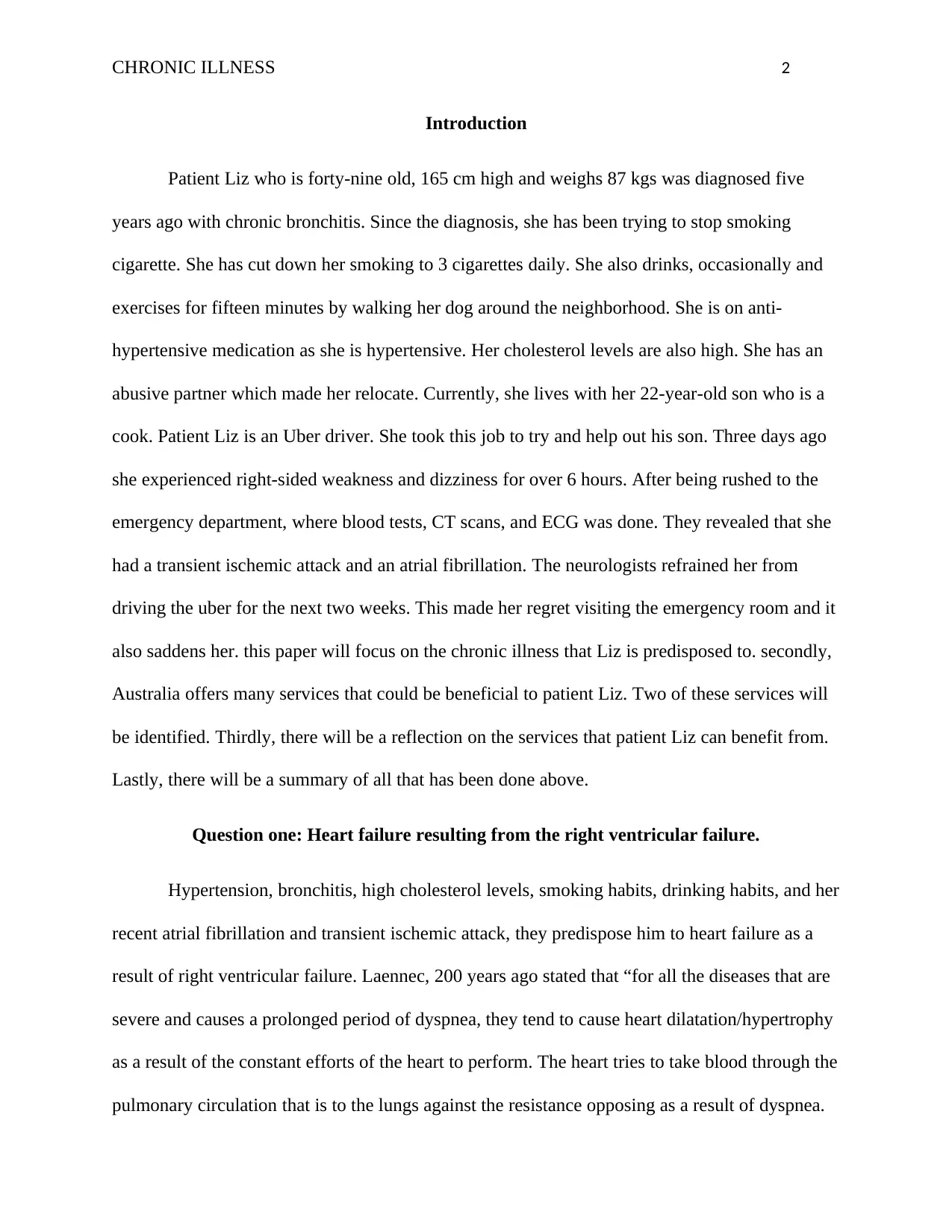
CHRONIC ILLNESS 2
Introduction
Patient Liz who is forty-nine old, 165 cm high and weighs 87 kgs was diagnosed five
years ago with chronic bronchitis. Since the diagnosis, she has been trying to stop smoking
cigarette. She has cut down her smoking to 3 cigarettes daily. She also drinks, occasionally and
exercises for fifteen minutes by walking her dog around the neighborhood. She is on anti-
hypertensive medication as she is hypertensive. Her cholesterol levels are also high. She has an
abusive partner which made her relocate. Currently, she lives with her 22-year-old son who is a
cook. Patient Liz is an Uber driver. She took this job to try and help out his son. Three days ago
she experienced right-sided weakness and dizziness for over 6 hours. After being rushed to the
emergency department, where blood tests, CT scans, and ECG was done. They revealed that she
had a transient ischemic attack and an atrial fibrillation. The neurologists refrained her from
driving the uber for the next two weeks. This made her regret visiting the emergency room and it
also saddens her. this paper will focus on the chronic illness that Liz is predisposed to. secondly,
Australia offers many services that could be beneficial to patient Liz. Two of these services will
be identified. Thirdly, there will be a reflection on the services that patient Liz can benefit from.
Lastly, there will be a summary of all that has been done above.
Question one: Heart failure resulting from the right ventricular failure.
Hypertension, bronchitis, high cholesterol levels, smoking habits, drinking habits, and her
recent atrial fibrillation and transient ischemic attack, they predispose him to heart failure as a
result of right ventricular failure. Laennec, 200 years ago stated that “for all the diseases that are
severe and causes a prolonged period of dyspnea, they tend to cause heart dilatation/hypertrophy
as a result of the constant efforts of the heart to perform. The heart tries to take blood through the
pulmonary circulation that is to the lungs against the resistance opposing as a result of dyspnea.
Introduction
Patient Liz who is forty-nine old, 165 cm high and weighs 87 kgs was diagnosed five
years ago with chronic bronchitis. Since the diagnosis, she has been trying to stop smoking
cigarette. She has cut down her smoking to 3 cigarettes daily. She also drinks, occasionally and
exercises for fifteen minutes by walking her dog around the neighborhood. She is on anti-
hypertensive medication as she is hypertensive. Her cholesterol levels are also high. She has an
abusive partner which made her relocate. Currently, she lives with her 22-year-old son who is a
cook. Patient Liz is an Uber driver. She took this job to try and help out his son. Three days ago
she experienced right-sided weakness and dizziness for over 6 hours. After being rushed to the
emergency department, where blood tests, CT scans, and ECG was done. They revealed that she
had a transient ischemic attack and an atrial fibrillation. The neurologists refrained her from
driving the uber for the next two weeks. This made her regret visiting the emergency room and it
also saddens her. this paper will focus on the chronic illness that Liz is predisposed to. secondly,
Australia offers many services that could be beneficial to patient Liz. Two of these services will
be identified. Thirdly, there will be a reflection on the services that patient Liz can benefit from.
Lastly, there will be a summary of all that has been done above.
Question one: Heart failure resulting from the right ventricular failure.
Hypertension, bronchitis, high cholesterol levels, smoking habits, drinking habits, and her
recent atrial fibrillation and transient ischemic attack, they predispose him to heart failure as a
result of right ventricular failure. Laennec, 200 years ago stated that “for all the diseases that are
severe and causes a prolonged period of dyspnea, they tend to cause heart dilatation/hypertrophy
as a result of the constant efforts of the heart to perform. The heart tries to take blood through the
pulmonary circulation that is to the lungs against the resistance opposing as a result of dyspnea.
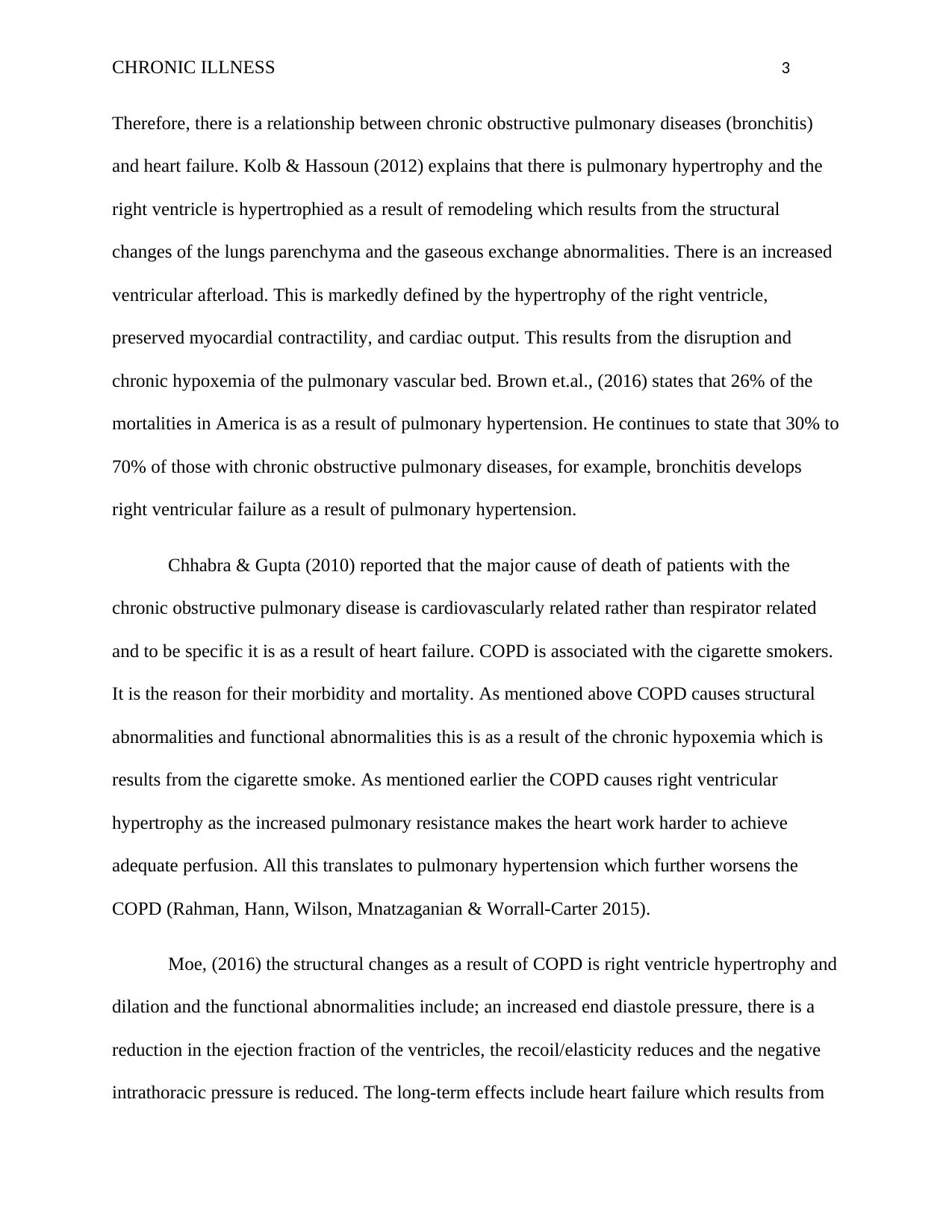
CHRONIC ILLNESS 3
Therefore, there is a relationship between chronic obstructive pulmonary diseases (bronchitis)
and heart failure. Kolb & Hassoun (2012) explains that there is pulmonary hypertrophy and the
right ventricle is hypertrophied as a result of remodeling which results from the structural
changes of the lungs parenchyma and the gaseous exchange abnormalities. There is an increased
ventricular afterload. This is markedly defined by the hypertrophy of the right ventricle,
preserved myocardial contractility, and cardiac output. This results from the disruption and
chronic hypoxemia of the pulmonary vascular bed. Brown et.al., (2016) states that 26% of the
mortalities in America is as a result of pulmonary hypertension. He continues to state that 30% to
70% of those with chronic obstructive pulmonary diseases, for example, bronchitis develops
right ventricular failure as a result of pulmonary hypertension.
Chhabra & Gupta (2010) reported that the major cause of death of patients with the
chronic obstructive pulmonary disease is cardiovascularly related rather than respirator related
and to be specific it is as a result of heart failure. COPD is associated with the cigarette smokers.
It is the reason for their morbidity and mortality. As mentioned above COPD causes structural
abnormalities and functional abnormalities this is as a result of the chronic hypoxemia which is
results from the cigarette smoke. As mentioned earlier the COPD causes right ventricular
hypertrophy as the increased pulmonary resistance makes the heart work harder to achieve
adequate perfusion. All this translates to pulmonary hypertension which further worsens the
COPD (Rahman, Hann, Wilson, Mnatzaganian & Worrall-Carter 2015).
Moe, (2016) the structural changes as a result of COPD is right ventricle hypertrophy and
dilation and the functional abnormalities include; an increased end diastole pressure, there is a
reduction in the ejection fraction of the ventricles, the recoil/elasticity reduces and the negative
intrathoracic pressure is reduced. The long-term effects include heart failure which results from
Therefore, there is a relationship between chronic obstructive pulmonary diseases (bronchitis)
and heart failure. Kolb & Hassoun (2012) explains that there is pulmonary hypertrophy and the
right ventricle is hypertrophied as a result of remodeling which results from the structural
changes of the lungs parenchyma and the gaseous exchange abnormalities. There is an increased
ventricular afterload. This is markedly defined by the hypertrophy of the right ventricle,
preserved myocardial contractility, and cardiac output. This results from the disruption and
chronic hypoxemia of the pulmonary vascular bed. Brown et.al., (2016) states that 26% of the
mortalities in America is as a result of pulmonary hypertension. He continues to state that 30% to
70% of those with chronic obstructive pulmonary diseases, for example, bronchitis develops
right ventricular failure as a result of pulmonary hypertension.
Chhabra & Gupta (2010) reported that the major cause of death of patients with the
chronic obstructive pulmonary disease is cardiovascularly related rather than respirator related
and to be specific it is as a result of heart failure. COPD is associated with the cigarette smokers.
It is the reason for their morbidity and mortality. As mentioned above COPD causes structural
abnormalities and functional abnormalities this is as a result of the chronic hypoxemia which is
results from the cigarette smoke. As mentioned earlier the COPD causes right ventricular
hypertrophy as the increased pulmonary resistance makes the heart work harder to achieve
adequate perfusion. All this translates to pulmonary hypertension which further worsens the
COPD (Rahman, Hann, Wilson, Mnatzaganian & Worrall-Carter 2015).
Moe, (2016) the structural changes as a result of COPD is right ventricle hypertrophy and
dilation and the functional abnormalities include; an increased end diastole pressure, there is a
reduction in the ejection fraction of the ventricles, the recoil/elasticity reduces and the negative
intrathoracic pressure is reduced. The long-term effects include heart failure which results from
⊘ This is a preview!⊘
Do you want full access?
Subscribe today to unlock all pages.

Trusted by 1+ million students worldwide
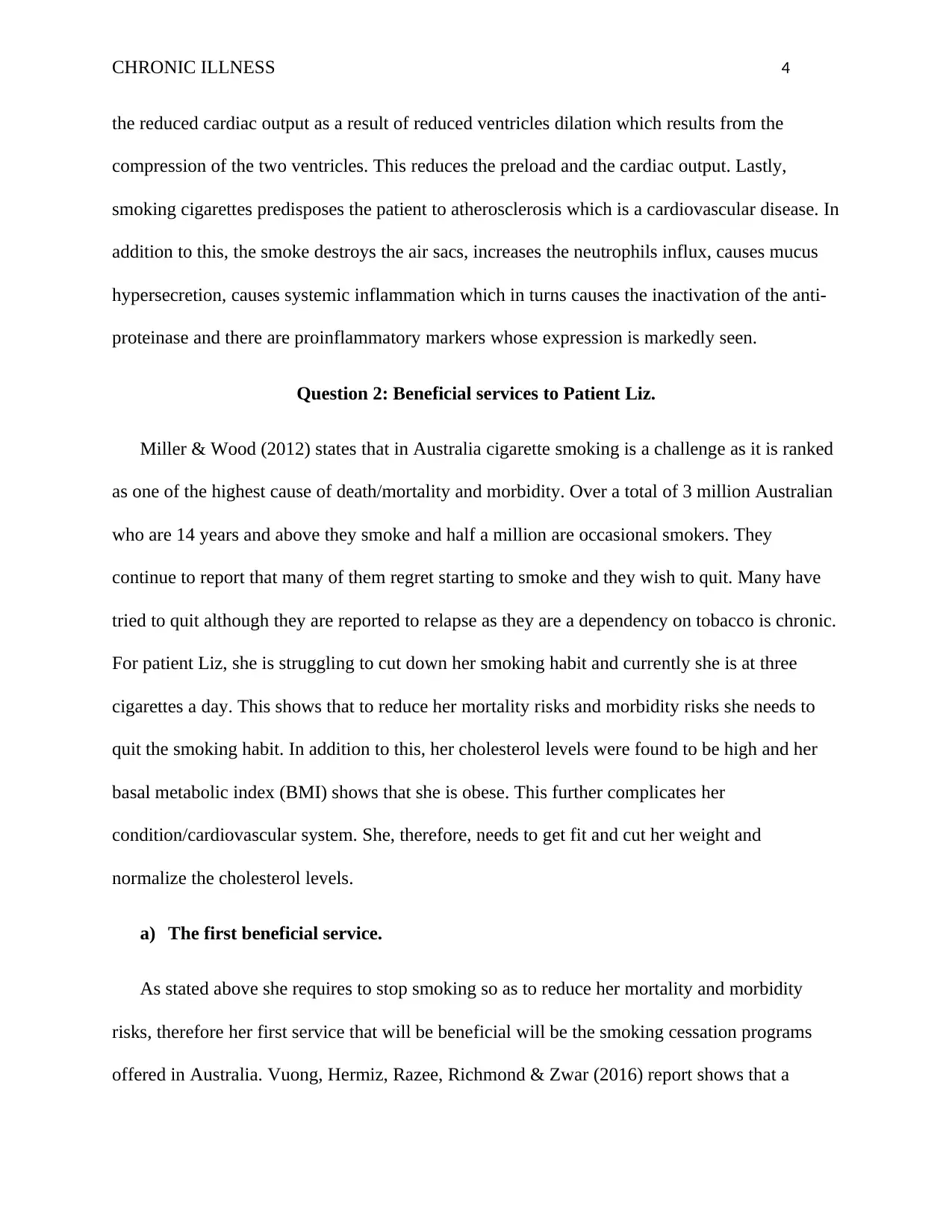
CHRONIC ILLNESS 4
the reduced cardiac output as a result of reduced ventricles dilation which results from the
compression of the two ventricles. This reduces the preload and the cardiac output. Lastly,
smoking cigarettes predisposes the patient to atherosclerosis which is a cardiovascular disease. In
addition to this, the smoke destroys the air sacs, increases the neutrophils influx, causes mucus
hypersecretion, causes systemic inflammation which in turns causes the inactivation of the anti-
proteinase and there are proinflammatory markers whose expression is markedly seen.
Question 2: Beneficial services to Patient Liz.
Miller & Wood (2012) states that in Australia cigarette smoking is a challenge as it is ranked
as one of the highest cause of death/mortality and morbidity. Over a total of 3 million Australian
who are 14 years and above they smoke and half a million are occasional smokers. They
continue to report that many of them regret starting to smoke and they wish to quit. Many have
tried to quit although they are reported to relapse as they are a dependency on tobacco is chronic.
For patient Liz, she is struggling to cut down her smoking habit and currently she is at three
cigarettes a day. This shows that to reduce her mortality risks and morbidity risks she needs to
quit the smoking habit. In addition to this, her cholesterol levels were found to be high and her
basal metabolic index (BMI) shows that she is obese. This further complicates her
condition/cardiovascular system. She, therefore, needs to get fit and cut her weight and
normalize the cholesterol levels.
a) The first beneficial service.
As stated above she requires to stop smoking so as to reduce her mortality and morbidity
risks, therefore her first service that will be beneficial will be the smoking cessation programs
offered in Australia. Vuong, Hermiz, Razee, Richmond & Zwar (2016) report shows that a
the reduced cardiac output as a result of reduced ventricles dilation which results from the
compression of the two ventricles. This reduces the preload and the cardiac output. Lastly,
smoking cigarettes predisposes the patient to atherosclerosis which is a cardiovascular disease. In
addition to this, the smoke destroys the air sacs, increases the neutrophils influx, causes mucus
hypersecretion, causes systemic inflammation which in turns causes the inactivation of the anti-
proteinase and there are proinflammatory markers whose expression is markedly seen.
Question 2: Beneficial services to Patient Liz.
Miller & Wood (2012) states that in Australia cigarette smoking is a challenge as it is ranked
as one of the highest cause of death/mortality and morbidity. Over a total of 3 million Australian
who are 14 years and above they smoke and half a million are occasional smokers. They
continue to report that many of them regret starting to smoke and they wish to quit. Many have
tried to quit although they are reported to relapse as they are a dependency on tobacco is chronic.
For patient Liz, she is struggling to cut down her smoking habit and currently she is at three
cigarettes a day. This shows that to reduce her mortality risks and morbidity risks she needs to
quit the smoking habit. In addition to this, her cholesterol levels were found to be high and her
basal metabolic index (BMI) shows that she is obese. This further complicates her
condition/cardiovascular system. She, therefore, needs to get fit and cut her weight and
normalize the cholesterol levels.
a) The first beneficial service.
As stated above she requires to stop smoking so as to reduce her mortality and morbidity
risks, therefore her first service that will be beneficial will be the smoking cessation programs
offered in Australia. Vuong, Hermiz, Razee, Richmond & Zwar (2016) report shows that a
Paraphrase This Document
Need a fresh take? Get an instant paraphrase of this document with our AI Paraphraser
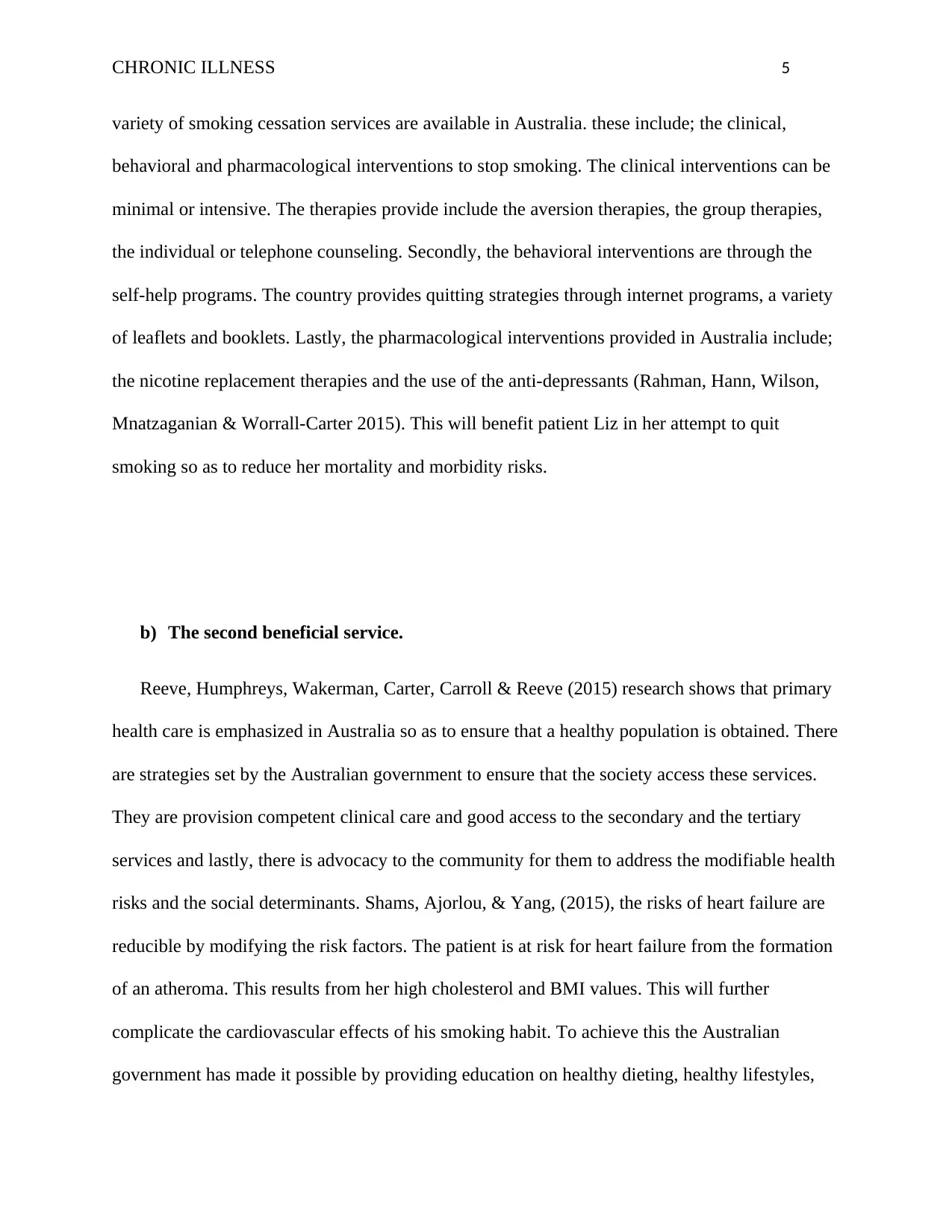
CHRONIC ILLNESS 5
variety of smoking cessation services are available in Australia. these include; the clinical,
behavioral and pharmacological interventions to stop smoking. The clinical interventions can be
minimal or intensive. The therapies provide include the aversion therapies, the group therapies,
the individual or telephone counseling. Secondly, the behavioral interventions are through the
self-help programs. The country provides quitting strategies through internet programs, a variety
of leaflets and booklets. Lastly, the pharmacological interventions provided in Australia include;
the nicotine replacement therapies and the use of the anti-depressants (Rahman, Hann, Wilson,
Mnatzaganian & Worrall-Carter 2015). This will benefit patient Liz in her attempt to quit
smoking so as to reduce her mortality and morbidity risks.
b) The second beneficial service.
Reeve, Humphreys, Wakerman, Carter, Carroll & Reeve (2015) research shows that primary
health care is emphasized in Australia so as to ensure that a healthy population is obtained. There
are strategies set by the Australian government to ensure that the society access these services.
They are provision competent clinical care and good access to the secondary and the tertiary
services and lastly, there is advocacy to the community for them to address the modifiable health
risks and the social determinants. Shams, Ajorlou, & Yang, (2015), the risks of heart failure are
reducible by modifying the risk factors. The patient is at risk for heart failure from the formation
of an atheroma. This results from her high cholesterol and BMI values. This will further
complicate the cardiovascular effects of his smoking habit. To achieve this the Australian
government has made it possible by providing education on healthy dieting, healthy lifestyles,
variety of smoking cessation services are available in Australia. these include; the clinical,
behavioral and pharmacological interventions to stop smoking. The clinical interventions can be
minimal or intensive. The therapies provide include the aversion therapies, the group therapies,
the individual or telephone counseling. Secondly, the behavioral interventions are through the
self-help programs. The country provides quitting strategies through internet programs, a variety
of leaflets and booklets. Lastly, the pharmacological interventions provided in Australia include;
the nicotine replacement therapies and the use of the anti-depressants (Rahman, Hann, Wilson,
Mnatzaganian & Worrall-Carter 2015). This will benefit patient Liz in her attempt to quit
smoking so as to reduce her mortality and morbidity risks.
b) The second beneficial service.
Reeve, Humphreys, Wakerman, Carter, Carroll & Reeve (2015) research shows that primary
health care is emphasized in Australia so as to ensure that a healthy population is obtained. There
are strategies set by the Australian government to ensure that the society access these services.
They are provision competent clinical care and good access to the secondary and the tertiary
services and lastly, there is advocacy to the community for them to address the modifiable health
risks and the social determinants. Shams, Ajorlou, & Yang, (2015), the risks of heart failure are
reducible by modifying the risk factors. The patient is at risk for heart failure from the formation
of an atheroma. This results from her high cholesterol and BMI values. This will further
complicate the cardiovascular effects of his smoking habit. To achieve this the Australian
government has made it possible by providing education on healthy dieting, healthy lifestyles,
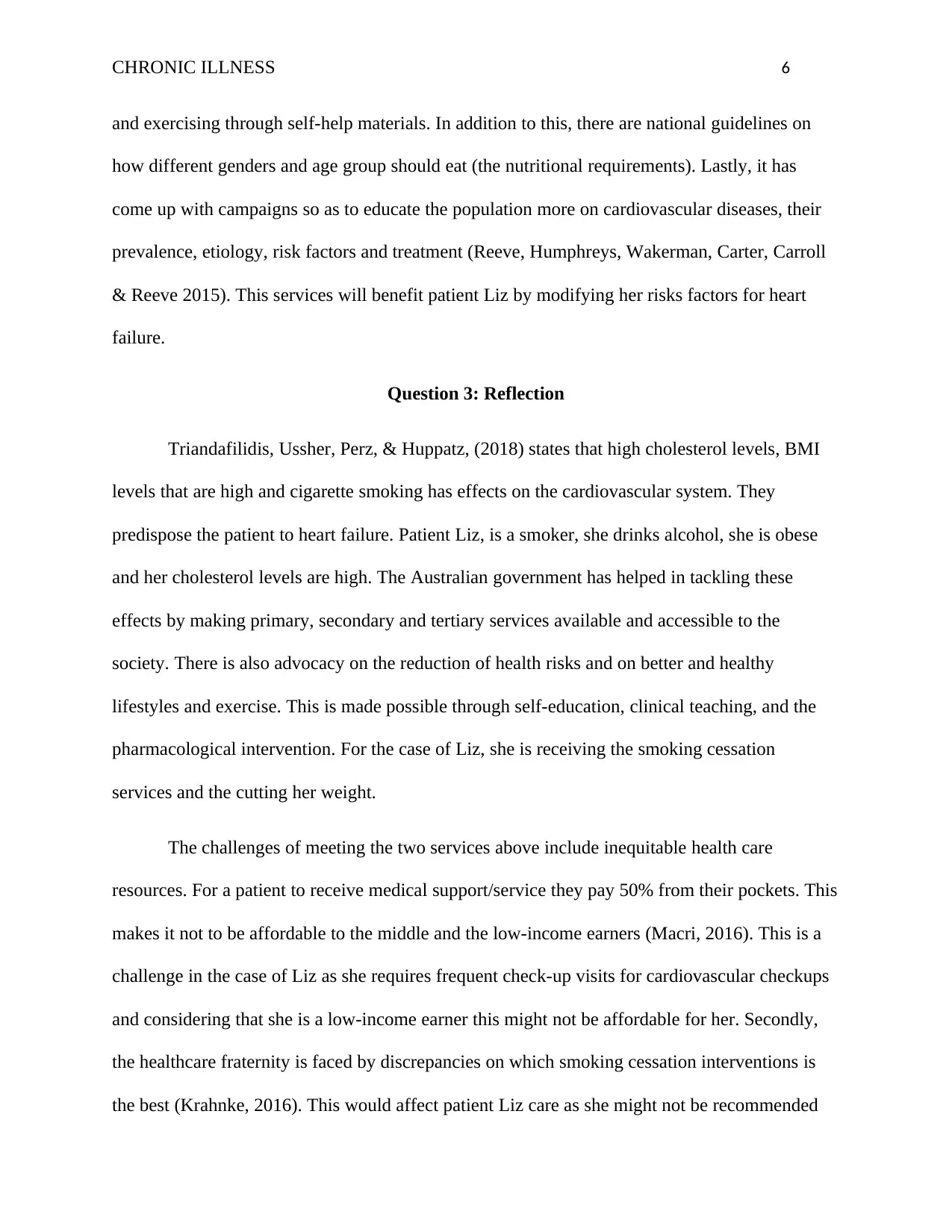
CHRONIC ILLNESS 6
and exercising through self-help materials. In addition to this, there are national guidelines on
how different genders and age group should eat (the nutritional requirements). Lastly, it has
come up with campaigns so as to educate the population more on cardiovascular diseases, their
prevalence, etiology, risk factors and treatment (Reeve, Humphreys, Wakerman, Carter, Carroll
& Reeve 2015). This services will benefit patient Liz by modifying her risks factors for heart
failure.
Question 3: Reflection
Triandafilidis, Ussher, Perz, & Huppatz, (2018) states that high cholesterol levels, BMI
levels that are high and cigarette smoking has effects on the cardiovascular system. They
predispose the patient to heart failure. Patient Liz, is a smoker, she drinks alcohol, she is obese
and her cholesterol levels are high. The Australian government has helped in tackling these
effects by making primary, secondary and tertiary services available and accessible to the
society. There is also advocacy on the reduction of health risks and on better and healthy
lifestyles and exercise. This is made possible through self-education, clinical teaching, and the
pharmacological intervention. For the case of Liz, she is receiving the smoking cessation
services and the cutting her weight.
The challenges of meeting the two services above include inequitable health care
resources. For a patient to receive medical support/service they pay 50% from their pockets. This
makes it not to be affordable to the middle and the low-income earners (Macri, 2016). This is a
challenge in the case of Liz as she requires frequent check-up visits for cardiovascular checkups
and considering that she is a low-income earner this might not be affordable for her. Secondly,
the healthcare fraternity is faced by discrepancies on which smoking cessation interventions is
the best (Krahnke, 2016). This would affect patient Liz care as she might not be recommended
and exercising through self-help materials. In addition to this, there are national guidelines on
how different genders and age group should eat (the nutritional requirements). Lastly, it has
come up with campaigns so as to educate the population more on cardiovascular diseases, their
prevalence, etiology, risk factors and treatment (Reeve, Humphreys, Wakerman, Carter, Carroll
& Reeve 2015). This services will benefit patient Liz by modifying her risks factors for heart
failure.
Question 3: Reflection
Triandafilidis, Ussher, Perz, & Huppatz, (2018) states that high cholesterol levels, BMI
levels that are high and cigarette smoking has effects on the cardiovascular system. They
predispose the patient to heart failure. Patient Liz, is a smoker, she drinks alcohol, she is obese
and her cholesterol levels are high. The Australian government has helped in tackling these
effects by making primary, secondary and tertiary services available and accessible to the
society. There is also advocacy on the reduction of health risks and on better and healthy
lifestyles and exercise. This is made possible through self-education, clinical teaching, and the
pharmacological intervention. For the case of Liz, she is receiving the smoking cessation
services and the cutting her weight.
The challenges of meeting the two services above include inequitable health care
resources. For a patient to receive medical support/service they pay 50% from their pockets. This
makes it not to be affordable to the middle and the low-income earners (Macri, 2016). This is a
challenge in the case of Liz as she requires frequent check-up visits for cardiovascular checkups
and considering that she is a low-income earner this might not be affordable for her. Secondly,
the healthcare fraternity is faced by discrepancies on which smoking cessation interventions is
the best (Krahnke, 2016). This would affect patient Liz care as she might not be recommended
⊘ This is a preview!⊘
Do you want full access?
Subscribe today to unlock all pages.

Trusted by 1+ million students worldwide
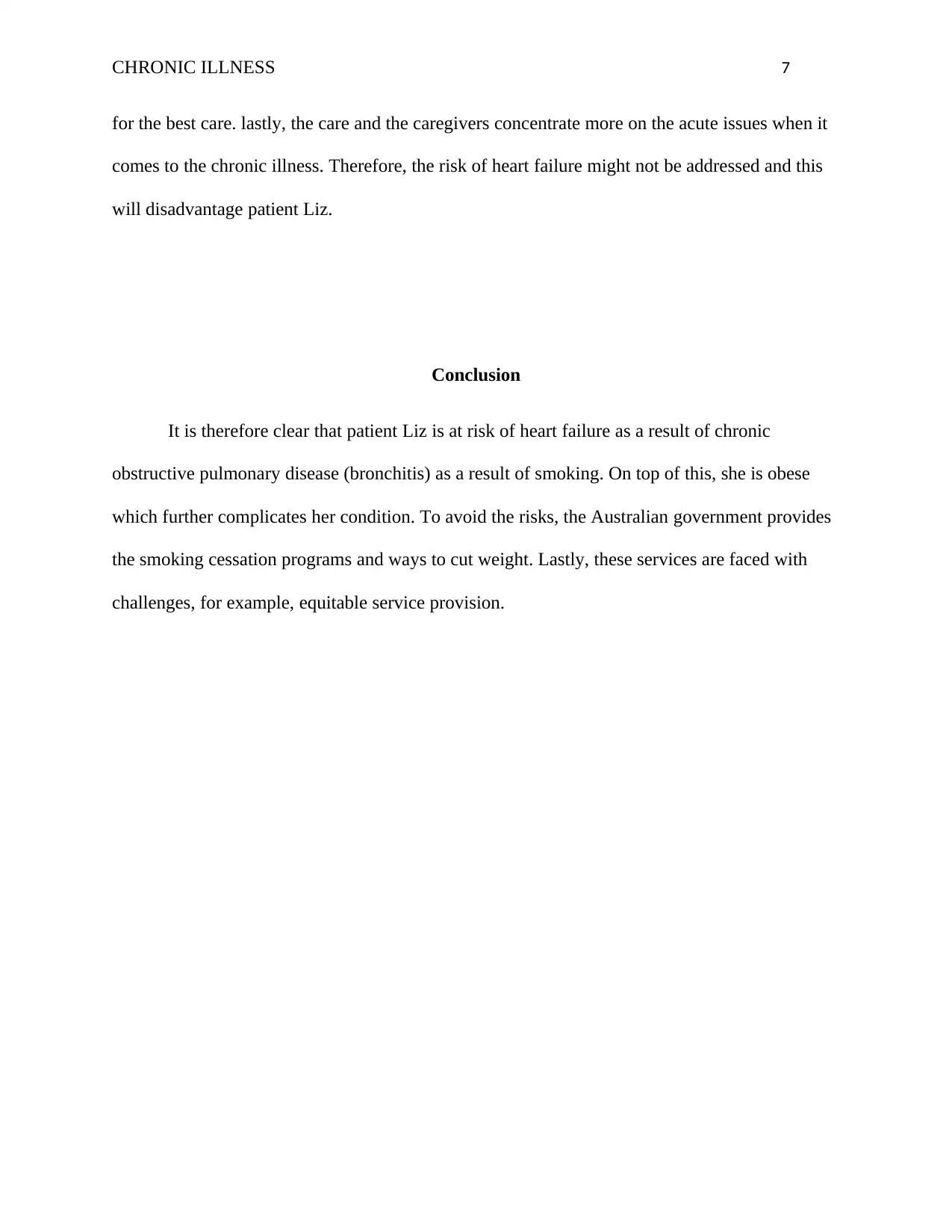
CHRONIC ILLNESS 7
for the best care. lastly, the care and the caregivers concentrate more on the acute issues when it
comes to the chronic illness. Therefore, the risk of heart failure might not be addressed and this
will disadvantage patient Liz.
Conclusion
It is therefore clear that patient Liz is at risk of heart failure as a result of chronic
obstructive pulmonary disease (bronchitis) as a result of smoking. On top of this, she is obese
which further complicates her condition. To avoid the risks, the Australian government provides
the smoking cessation programs and ways to cut weight. Lastly, these services are faced with
challenges, for example, equitable service provision.
for the best care. lastly, the care and the caregivers concentrate more on the acute issues when it
comes to the chronic illness. Therefore, the risk of heart failure might not be addressed and this
will disadvantage patient Liz.
Conclusion
It is therefore clear that patient Liz is at risk of heart failure as a result of chronic
obstructive pulmonary disease (bronchitis) as a result of smoking. On top of this, she is obese
which further complicates her condition. To avoid the risks, the Australian government provides
the smoking cessation programs and ways to cut weight. Lastly, these services are faced with
challenges, for example, equitable service provision.
Paraphrase This Document
Need a fresh take? Get an instant paraphrase of this document with our AI Paraphraser
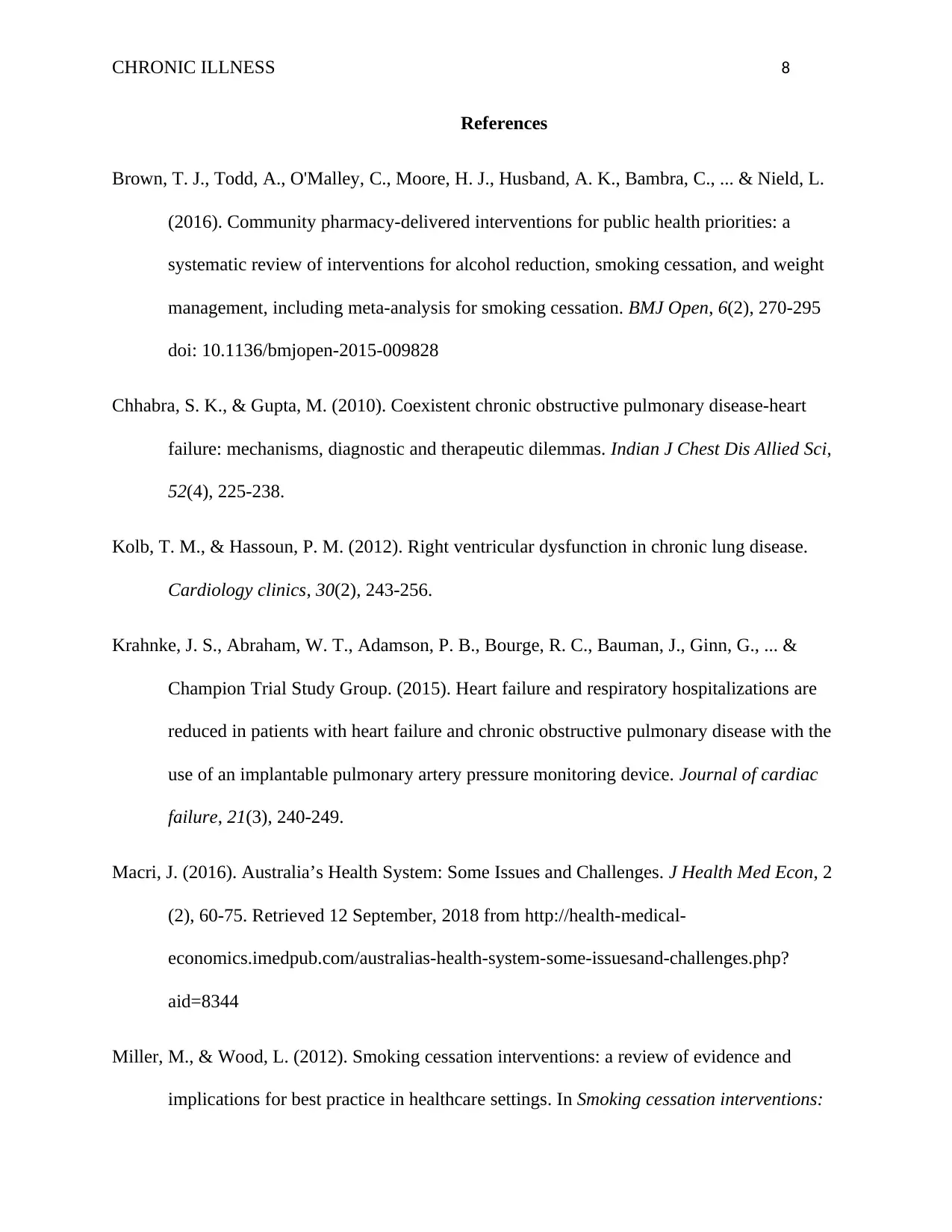
CHRONIC ILLNESS 8
References
Brown, T. J., Todd, A., O'Malley, C., Moore, H. J., Husband, A. K., Bambra, C., ... & Nield, L.
(2016). Community pharmacy-delivered interventions for public health priorities: a
systematic review of interventions for alcohol reduction, smoking cessation, and weight
management, including meta-analysis for smoking cessation. BMJ Open, 6(2), 270-295
doi: 10.1136/bmjopen-2015-009828
Chhabra, S. K., & Gupta, M. (2010). Coexistent chronic obstructive pulmonary disease-heart
failure: mechanisms, diagnostic and therapeutic dilemmas. Indian J Chest Dis Allied Sci,
52(4), 225-238.
Kolb, T. M., & Hassoun, P. M. (2012). Right ventricular dysfunction in chronic lung disease.
Cardiology clinics, 30(2), 243-256.
Krahnke, J. S., Abraham, W. T., Adamson, P. B., Bourge, R. C., Bauman, J., Ginn, G., ... &
Champion Trial Study Group. (2015). Heart failure and respiratory hospitalizations are
reduced in patients with heart failure and chronic obstructive pulmonary disease with the
use of an implantable pulmonary artery pressure monitoring device. Journal of cardiac
failure, 21(3), 240-249.
Macri, J. (2016). Australia’s Health System: Some Issues and Challenges. J Health Med Econ, 2
(2), 60-75. Retrieved 12 September, 2018 from http://health-medical-
economics.imedpub.com/australias-health-system-some-issuesand-challenges.php?
aid=8344
Miller, M., & Wood, L. (2012). Smoking cessation interventions: a review of evidence and
implications for best practice in healthcare settings. In Smoking cessation interventions:
References
Brown, T. J., Todd, A., O'Malley, C., Moore, H. J., Husband, A. K., Bambra, C., ... & Nield, L.
(2016). Community pharmacy-delivered interventions for public health priorities: a
systematic review of interventions for alcohol reduction, smoking cessation, and weight
management, including meta-analysis for smoking cessation. BMJ Open, 6(2), 270-295
doi: 10.1136/bmjopen-2015-009828
Chhabra, S. K., & Gupta, M. (2010). Coexistent chronic obstructive pulmonary disease-heart
failure: mechanisms, diagnostic and therapeutic dilemmas. Indian J Chest Dis Allied Sci,
52(4), 225-238.
Kolb, T. M., & Hassoun, P. M. (2012). Right ventricular dysfunction in chronic lung disease.
Cardiology clinics, 30(2), 243-256.
Krahnke, J. S., Abraham, W. T., Adamson, P. B., Bourge, R. C., Bauman, J., Ginn, G., ... &
Champion Trial Study Group. (2015). Heart failure and respiratory hospitalizations are
reduced in patients with heart failure and chronic obstructive pulmonary disease with the
use of an implantable pulmonary artery pressure monitoring device. Journal of cardiac
failure, 21(3), 240-249.
Macri, J. (2016). Australia’s Health System: Some Issues and Challenges. J Health Med Econ, 2
(2), 60-75. Retrieved 12 September, 2018 from http://health-medical-
economics.imedpub.com/australias-health-system-some-issuesand-challenges.php?
aid=8344
Miller, M., & Wood, L. (2012). Smoking cessation interventions: a review of evidence and
implications for best practice in healthcare settings. In Smoking cessation interventions:
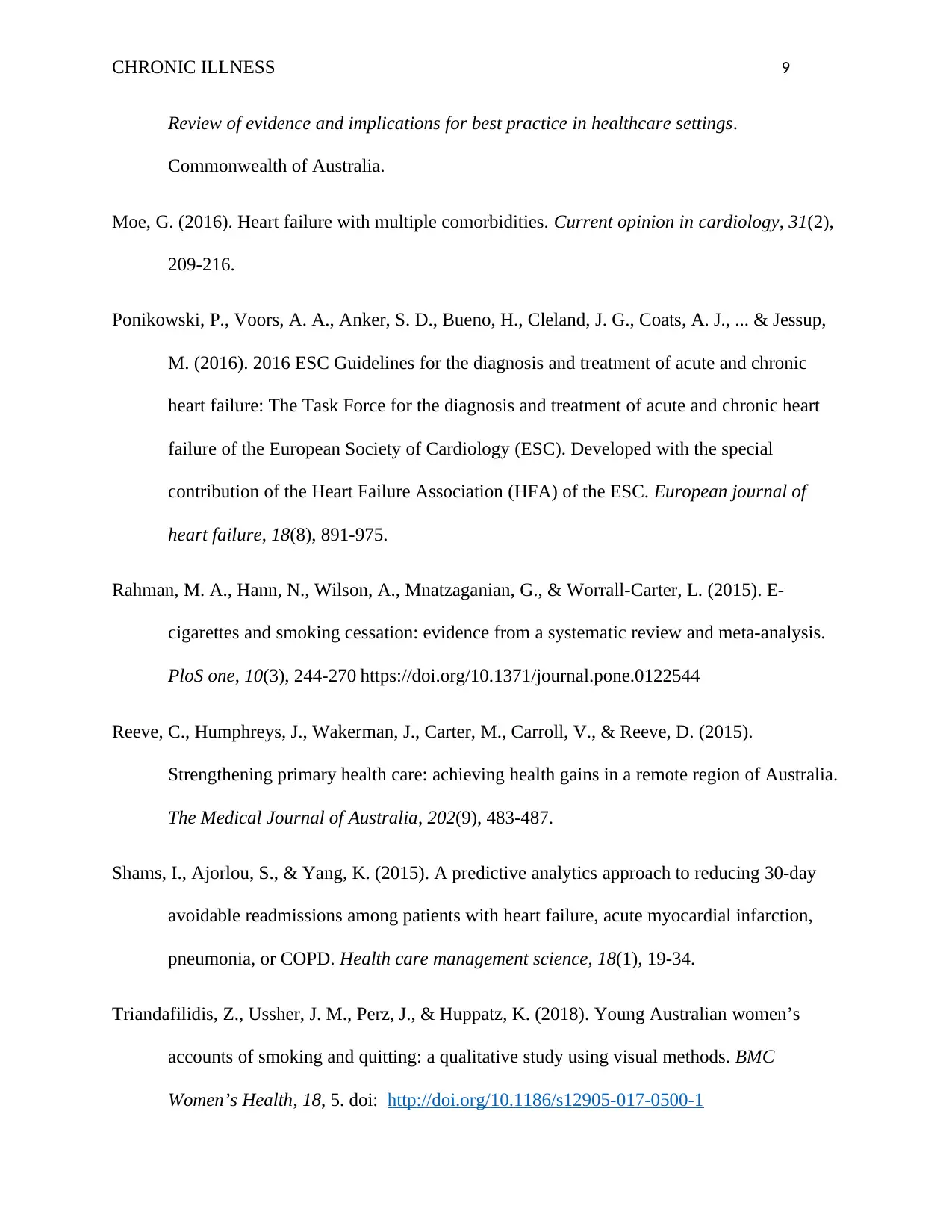
CHRONIC ILLNESS 9
Review of evidence and implications for best practice in healthcare settings.
Commonwealth of Australia.
Moe, G. (2016). Heart failure with multiple comorbidities. Current opinion in cardiology, 31(2),
209-216.
Ponikowski, P., Voors, A. A., Anker, S. D., Bueno, H., Cleland, J. G., Coats, A. J., ... & Jessup,
M. (2016). 2016 ESC Guidelines for the diagnosis and treatment of acute and chronic
heart failure: The Task Force for the diagnosis and treatment of acute and chronic heart
failure of the European Society of Cardiology (ESC). Developed with the special
contribution of the Heart Failure Association (HFA) of the ESC. European journal of
heart failure, 18(8), 891-975.
Rahman, M. A., Hann, N., Wilson, A., Mnatzaganian, G., & Worrall-Carter, L. (2015). E-
cigarettes and smoking cessation: evidence from a systematic review and meta-analysis.
PloS one, 10(3), 244-270 https://doi.org/10.1371/journal.pone.0122544
Reeve, C., Humphreys, J., Wakerman, J., Carter, M., Carroll, V., & Reeve, D. (2015).
Strengthening primary health care: achieving health gains in a remote region of Australia.
The Medical Journal of Australia, 202(9), 483-487.
Shams, I., Ajorlou, S., & Yang, K. (2015). A predictive analytics approach to reducing 30-day
avoidable readmissions among patients with heart failure, acute myocardial infarction,
pneumonia, or COPD. Health care management science, 18(1), 19-34.
Triandafilidis, Z., Ussher, J. M., Perz, J., & Huppatz, K. (2018). Young Australian women’s
accounts of smoking and quitting: a qualitative study using visual methods. BMC
Women’s Health, 18, 5. doi: http://doi.org/10.1186/s12905-017-0500-1
Review of evidence and implications for best practice in healthcare settings.
Commonwealth of Australia.
Moe, G. (2016). Heart failure with multiple comorbidities. Current opinion in cardiology, 31(2),
209-216.
Ponikowski, P., Voors, A. A., Anker, S. D., Bueno, H., Cleland, J. G., Coats, A. J., ... & Jessup,
M. (2016). 2016 ESC Guidelines for the diagnosis and treatment of acute and chronic
heart failure: The Task Force for the diagnosis and treatment of acute and chronic heart
failure of the European Society of Cardiology (ESC). Developed with the special
contribution of the Heart Failure Association (HFA) of the ESC. European journal of
heart failure, 18(8), 891-975.
Rahman, M. A., Hann, N., Wilson, A., Mnatzaganian, G., & Worrall-Carter, L. (2015). E-
cigarettes and smoking cessation: evidence from a systematic review and meta-analysis.
PloS one, 10(3), 244-270 https://doi.org/10.1371/journal.pone.0122544
Reeve, C., Humphreys, J., Wakerman, J., Carter, M., Carroll, V., & Reeve, D. (2015).
Strengthening primary health care: achieving health gains in a remote region of Australia.
The Medical Journal of Australia, 202(9), 483-487.
Shams, I., Ajorlou, S., & Yang, K. (2015). A predictive analytics approach to reducing 30-day
avoidable readmissions among patients with heart failure, acute myocardial infarction,
pneumonia, or COPD. Health care management science, 18(1), 19-34.
Triandafilidis, Z., Ussher, J. M., Perz, J., & Huppatz, K. (2018). Young Australian women’s
accounts of smoking and quitting: a qualitative study using visual methods. BMC
Women’s Health, 18, 5. doi: http://doi.org/10.1186/s12905-017-0500-1
⊘ This is a preview!⊘
Do you want full access?
Subscribe today to unlock all pages.

Trusted by 1+ million students worldwide

CHRONIC ILLNESS 10
Vuong, K., Hermiz, O., Razee, H., Richmond, R., & Zwar, N. (2016). The experiences of
smoking cessation among patients with chronic obstructive pulmonary disease in
Australian general practice: a qualitative descriptive study. Family practice, 33(6), 715-
720.
Vuong, K., Hermiz, O., Razee, H., Richmond, R., & Zwar, N. (2016). The experiences of
smoking cessation among patients with chronic obstructive pulmonary disease in
Australian general practice: a qualitative descriptive study. Family practice, 33(6), 715-
720.
1 out of 10
Related Documents
Your All-in-One AI-Powered Toolkit for Academic Success.
+13062052269
info@desklib.com
Available 24*7 on WhatsApp / Email
![[object Object]](/_next/static/media/star-bottom.7253800d.svg)
Unlock your academic potential
Copyright © 2020–2025 A2Z Services. All Rights Reserved. Developed and managed by ZUCOL.





